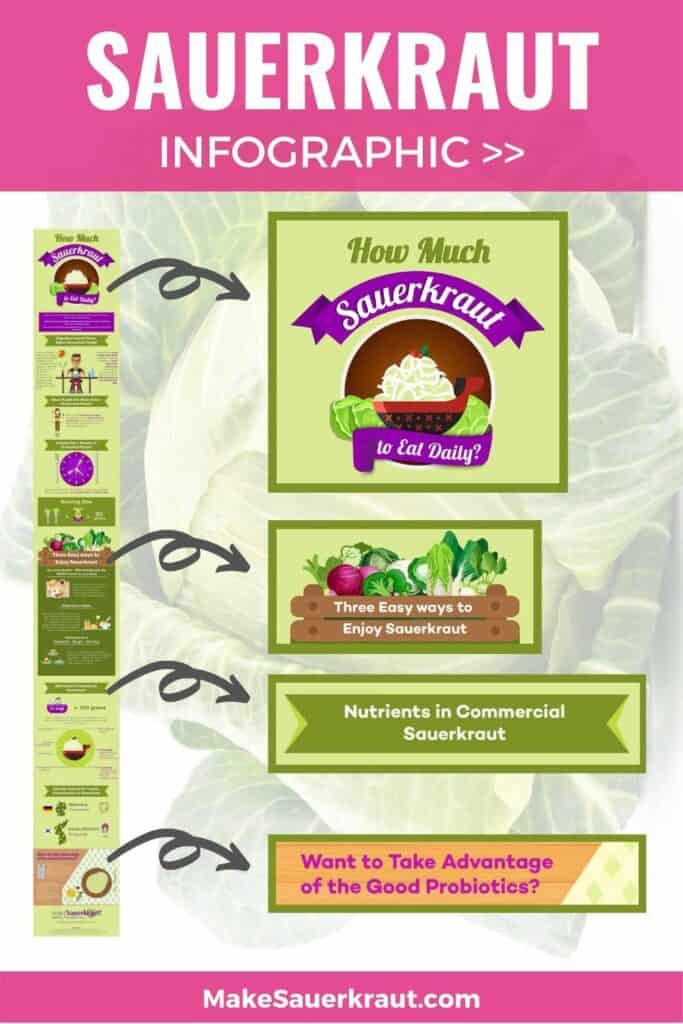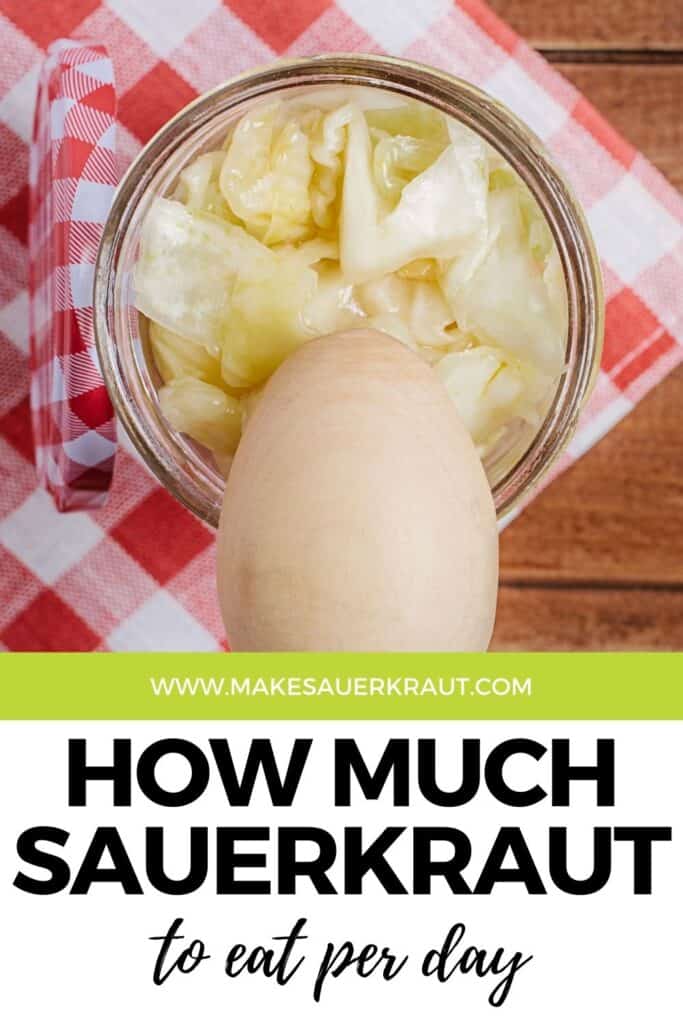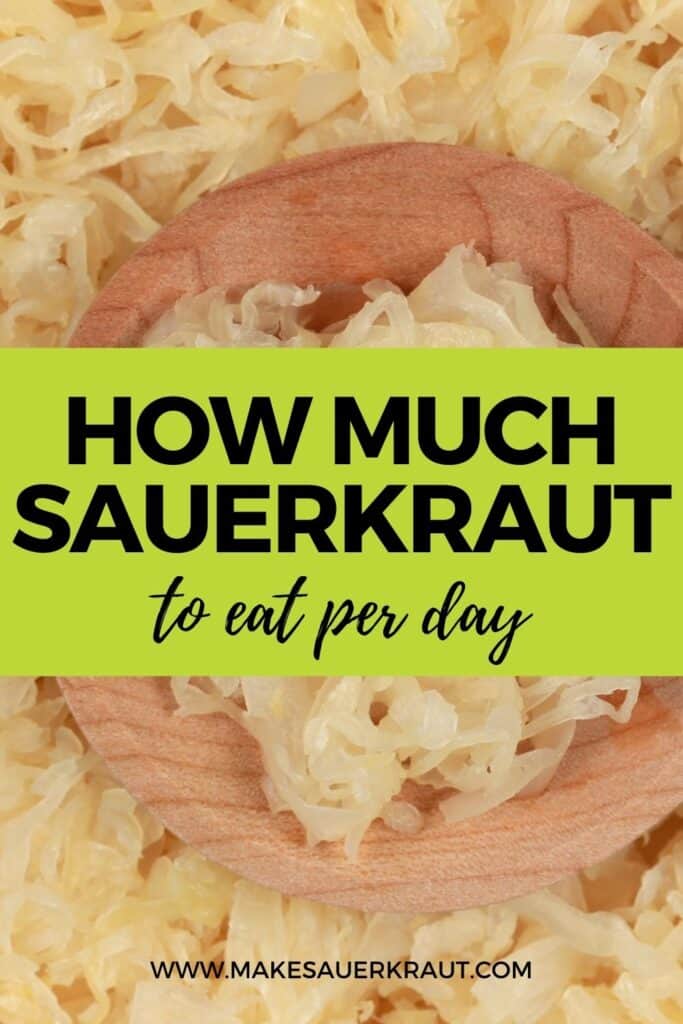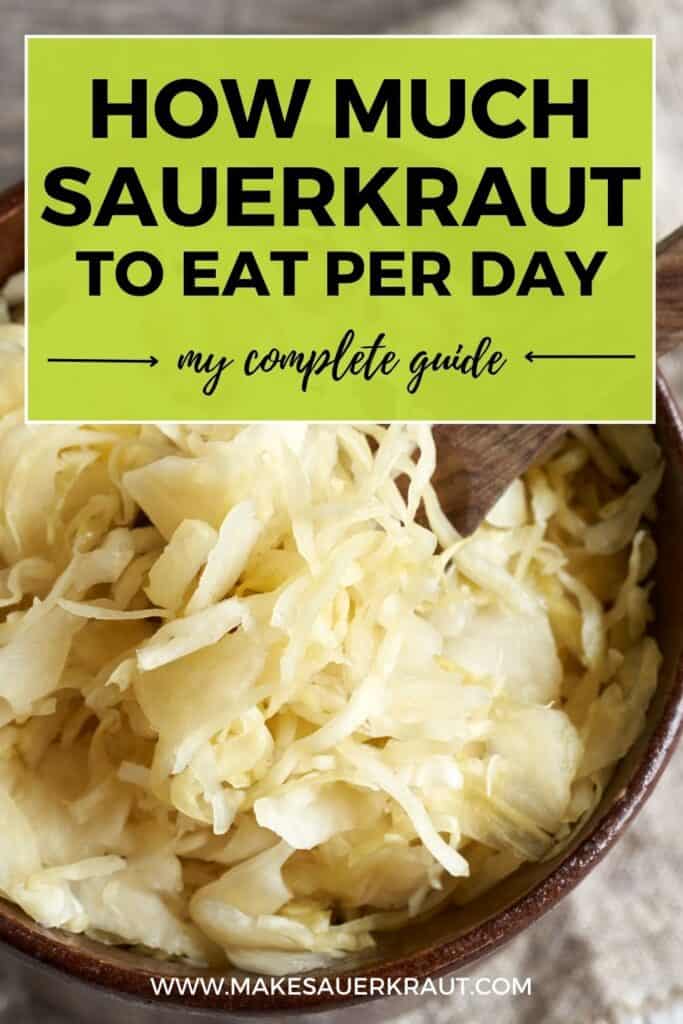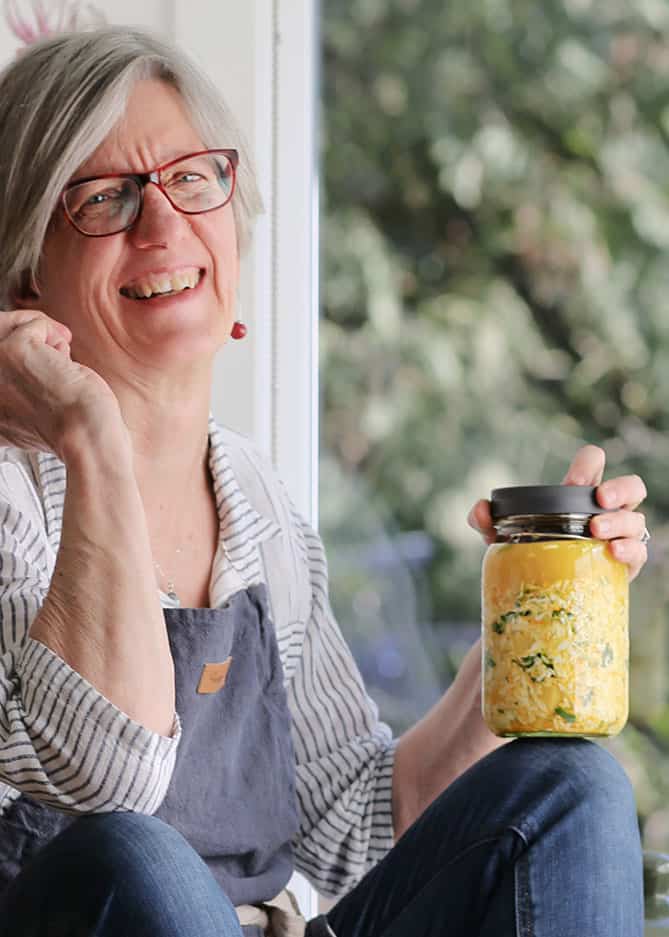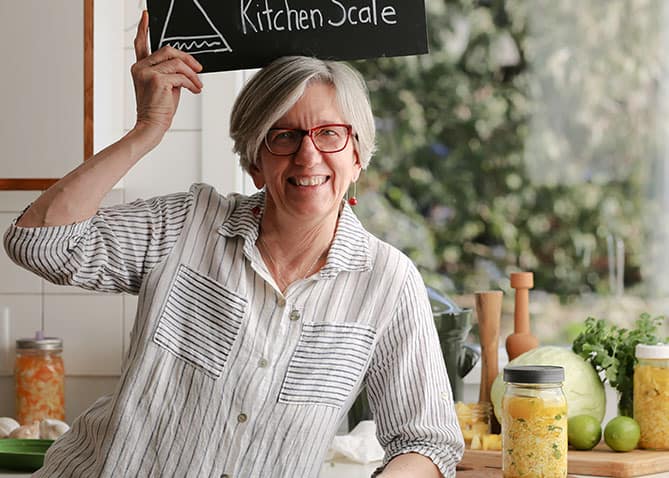Discover the secret to boosting your gut health and enhancing your daily diet with just a forkful of sauerkraut! Our comprehensive guide reveals how much sauerkraut per day is ideal for optimizing digestion, immunity, and overall well-being, along with tips to easily incorporate this superfood into your meals.
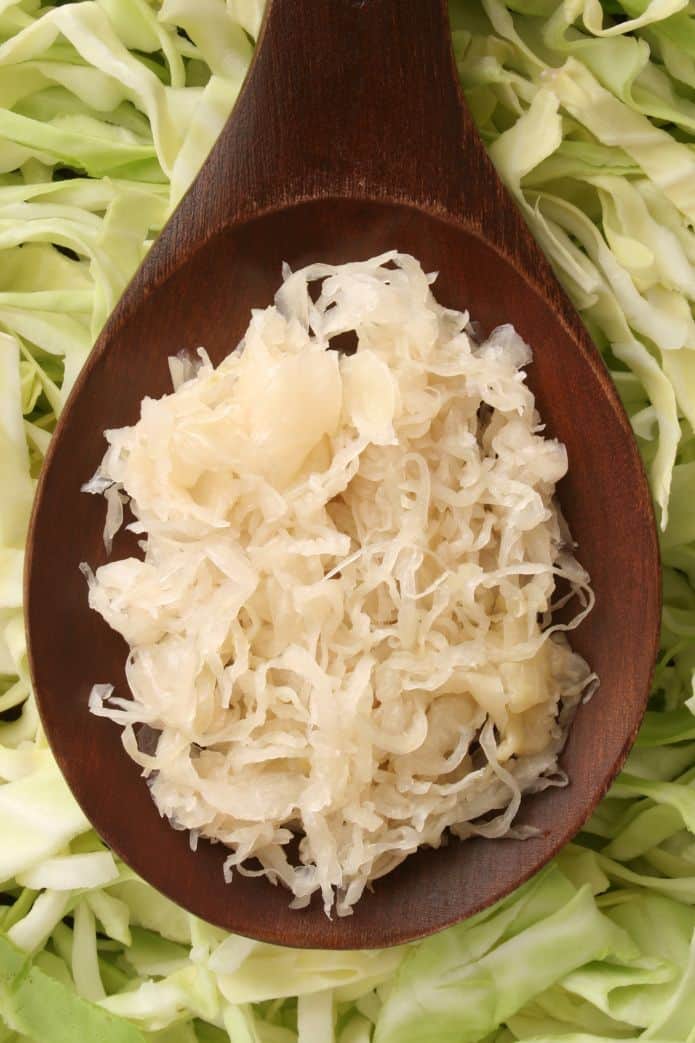
Sauerkraut is a fermented food made from cabbage and salt, celebrated for its distinctive sour taste and rich probiotic content.
It promotes a healthy gut microbiome, aiding digestion and enhancing the immune system. Additionally, sauerkraut is packed with vitamins C and K, fiber, and antioxidants, making it a nutritious addition to any diet for overall well-being.
In Korea, where the tradition of eating over 100 varieties of kimchi—a Korean style of fermented cabbage akin to sauerkraut—is deeply ingrained in the culture, it’s a daily way of life to enjoy this staple at breakfast, lunch, and dinner.
Meanwhile, outside of Korea, many might find themselves uncertain about not only the appropriate quantity to consume but also how to introduce fermented foods, such as sauerkraut, into their diets.
How much sauerkraut to eat daily?
For a healthy individual, it is recommended that you eat 1-2 forkfuls of sauerkraut 2-3 times per day.
If you are dealing with health challenges, such as compromised digestion, or are on a salt-restrictive diet, read further for tips to get you started.
Sauerkraut, along with pickles and other fermented foods, has consistently been highlighted as a top food trend since I started this blog in 2014, signaling a growing movement toward recognizing the healing power of fermented foods.
As someone who passionately believes in the transformative health benefits of the food you eat, particularly sauerkraut, I’m thrilled. If you’re seeking gut-friendly options to combat issues like irritable bowel syndrome or bloating, sauerkraut could be a game-changer for you.
In this guide, learn how much sauerkraut to eat daily, what adjustments to make if your health is compromised, and easy ways to enjoy this powerful fermented food.
And don’t miss the helpful summary infographic at the end of this post.
Why Sauerkraut?
I have been on a mission to help others add sauerkraut to their diet since I had my first forkful over 20 years ago in 2002.
I found it delicious, especially once I developed a set of mouthwatering recipes and soon realized how I could put my gut’s health on autopilot and experience real changes in my health.
An Easy-to-Make, Delicious Addition to Your Meals
Sauerkraut is one of the easiest fermented foods to add to your diet to promote a healthy gut microbiome.
- Sauerkraut is a Versatile Addition to Every Meal: Easily incorporate sauerkraut into sandwiches, salads, or as a flavorful side dish. Effortlessly, it heightens flavors and awakens taste bugs—gut health on autopilot.
- Sauerkraut is Easy to Make: It requires just a few simple ingredients—cabbage and salt. Follow my ultimate sauerkraut guide, a step-by-step guide to making sauerkraut in a jar.
- Sauerkraut can be Made in Small Batches: With just a quart jar, you can practice the fermentation process and find your preferred taste and texture.
- Not just Caraway and Juniper Berries: Sauerkraut can be made in a delicious variety of flavors to appease all members of your household.
- Sauerkraut is the Ultimate Convenience Food: Imagine having a jar of sauerkraut always ready in your fridge, poised to be the perfect addition to any meal with zero preparation time.
- Sauerkraut is Safe to Eat: The centuries-old fermentation process naturally inhibits harmful bacteria, thanks to the lactic acid that develops, ensuring a safe-to-eat product. By following simple fermentation practices, such as using the correct salt concentration, sauerkraut becomes a reliably safe addition to your diet.
Dive into more reasons to enjoy sauerkraut, including some you’ve never heard of, that make adding just a forkful to your daily diet a wise choice.
Experience Real Changes in Your Health
Microbiology, allopathic and holistic medicine, and the culinary world have all embraced the health-boosting powers of live-cultured foods.
- Lacto-fermented foods, like sauerkraut, increase the action of hydrochloric acid for improved digestion. 😋
- Lacto-fermentation increases the bioavailability of minerals in your food, including manganese, calcium, and potassium, helping to add more minerals to your diet.
- The bacteria in fermented vegetables guard against shigella, salmonella, and e.coli. and other harmful pathogens.
- Sauerkraut contains choline, an amino acid that supports good liver health, and the production of acetylcholine, a neurotransmitter that helps with memory and protects against Alzheimer’s.
- Lacto-fermented foods can help build a more resilient immune system and possibly reduce vulnerability to viruses.
Three Tips to Get You Started
1. Start Slow
Sauerkraut, packed with probiotics and fiber, can disrupt your digestive system if introduced too hastily, leading to symptoms like gas, bloating, or diarrhea. This could mean your body isn’t yet accustomed to this new food, or you’ve added it to your diet too rapidly.
Begin with a small amount of sauerkraut to let your body gradually adjust. Start with just a forkful during a meal and monitor how you feel. Over a month or so, slowly increase your intake to 2-3 forkfuls at 2-3 meals a day.
A good sauerkraut serving size is 2-3 forkfuls, about 30 grams or 1 ounce.
2. Aim for Consistency
Pick one meal a deal and include sauerkraut with it on a consistent basis. When that has become an automatic habit, add in another meal. I generally enjoy a serving of sauerkraut with lunch and dinner.
Probiotic foods are most beneficial when you eat them regularly
3. Consume a Variety
Mix up your daily diet with a variety of fermented foods such as yogurt, pickles, fermented carrot sticks dipped in yogurt cheese, kombucha, fermented coconut water, or kefir to nourish your gut microbiome with a wide range of beneficial bacteria.
Reasons to Avoid or Reduce Consumption?
While sauerkraut is beneficial for many, there are certain health conditions where consuming sauerkraut might require caution or consultation with a healthcare provider. Here are some reasons to consider:
High Blood Pressure or Sodium Sensitivity: Sauerkraut contains salt, which is used in the fermentation process. People with high blood pressure, heart disease, or sodium sensitivity should be cautious due to its potential to contribute to increased blood pressure.
Thyroid Conditions: Sauerkraut is made from cabbage, a cruciferous vegetable that contains goitrogens, substances that can interfere with thyroid function. Individuals with thyroid conditions, especially those with hypothyroidism, should consult their doctor before adding sauerkraut to their diet.
Histamine Intolerance: Fermented foods like sauerkraut are high in histamines, the chemicals your body produces during allergic reactions. People with histamine intolerance may experience symptoms like headaches, rashes, or digestive issues when consuming fermented foods.
Gastrointestinal Conditions: Though sauerkraut can improve gut health, individuals with certain gastrointestinal conditions such as irritable bowel syndrome (IBS) or small intestinal bacterial overgrowth (SIBO) may find their symptoms worsen due to the high fiber and probiotic content.
Before making significant dietary changes or if you have any of the above conditions, it’s always wise to consult with a healthcare provider to ensure that adding sauerkraut to your diet is safe and beneficial for your specific health situation.
Do You Have Compromised Digestion?
Sauerkraut—and other fermented foods—are very powerful and can do wonders for healing digestion.
However, give your body—and the trillions of Mighty Microbes that live there—time to get used to this new food you’re sending their way.
- Start slow. Try just a forkful with one meal and see how your body reacts. Slowly, taking a month or so, work your way up to 2-3 forkfuls with 2-3 meals daily.
- Drink just the brine. If you have compromised digestion or difficulty digesting fiber, start with just the brine. Most likely, you will not have enough brine from your jar of fermented sauerkraut and may need to buy a couple of bottles of “Gut Shots”—or make your own—(the brine from sauerkraut) to slowly get your gut used to the wide range of probiotics.
Are You on a Salt-Restrictive Diet?
Sauerkraut is a condiment typically eaten in small quantities that should fit into a salt-restrictive diet but consult with your health practitioner to verify.
Here is the sodium content of homemade sauerkraut and common foods:
- 243 mg of salt in a 1-ounce (30 grams) serving of sauerkraut fermented with a 2.0% salt concentration. (What the sauerkraut recipes on my site call for.)
- 182 mg of salt in a 1-ounce (30 grams) serving of sauerkraut fermented with a 1.5% salt concentration.
- 850 mg of sodium in a 1/2 cup (125 ml) serving of Campbell’s Chicken Noodle Soup. Sorry, childhood memories.
- 246 mg of sodium in 1/2 cup (125 ml) of pizza sauce
- 216-240 mg of sodium in a 3/4 cup (175 ml) serving of instant oatmeal
- 736-970 mg of sodium in a 1 cup (250 ml) serving of cottage cheese
Here are some tips if you are on a salt-restrictive diet:
- Restrict serving size. You will still garner the probiotic benefits with a small serving of sauerkraut.
- Rinse off your sauerkraut. Give your sauerkraut a quick rinse before serving. This will wash off some, but not all, of the beneficial bacteria.
- Make sauerkraut using less salt. The recipes on my site use a 2% salt concentration. Research indicates that you can go as low as 1.5% salinity and still provide a safe home for the beneficial bacteria to proliferate and prevent the growth of molds and yeasts. When you weigh your ingredients and salt, it’s easier to adjust the amount of salt used.
FAQs: How Much Sauerkraut to Eat Per Day?
Should I Eat Sauerkraut on an Empty Stomach?
Eating sauerkraut on an empty stomach may aid in the digestion and absorption of nutrients from your food.
However, individual tolerance varies, and for some, eating sauerkraut on an empty stomach might cause discomfort, such as bloating or gas, especially if not accustomed to fermented foods.
Best Time to Eat Sauerkraut for Gut Health?
For optimal benefits, it’s best to eat enzyme-rich fermented foods like sauerkraut at the start of a meal.
This allows them to immediately begin aiding digestion upon reaching the stomach, equipping your gut with the healthy bacteria and enzymes necessary for effectively breaking down food.
How Often Should I Eat Sauerkraut
It is a good idea to consume some fermented food with every meal, whether that is sauerkraut, naturally fermented pickles, yogurt, kefir, etc.
However, if you are new to fermented foods, start slow with one new ferment and then gradually add in others.
How Much Bacteria in a Serving of Sauerkraut?
According to Sauerkraut And Gut Health:
Bacteria are measured in colony forming units (CFUs). Studies suggest that sauerkraut and other fermented foods contain 1 million to 1 billion CFUs per gram/millilitre. A tablespoon serving of sauerkraut weighs roughly ten grams, which means it could give you between 10 million to 10 billion CFUs.
Healthpath, How Much Sauerkraut for Gut Health
What is the Best Sauerkraut to Eat?
To reap the health benefits of consuming naturally fermented foods, you need to make sure that the store-bought sauerkraut you buy is still teeming with the beneficial bacteria, enzymes, and nutrients created during the fermentation process.
In my Sauerkraut Shopping Guide I share three key tips (along with additional guidelines):
- Look in the refrigerated section of the store.
- Look on the label for the right words to signify that the sauerkraut is alive.
- Look on the label to verify that only real ingredients are listed. No vinegar. No additives.
What are Some Ways to Eat Sauerkraut?
When looking for ways to eat sauerkraut, keep it simple. Eat some right out of the jar. Add a forkful to a salad. Or, place a bit of sauerkraut on your dinner plate.
You don’t need an elaborate recipe, nor do you need to eat a massive quantity to speed up your digestion or improve your health. Just one forkful of sauerkraut is teaming with enough beneficial bacteria to make noticeable, positive changes in your digestion.
Here are a few suggestions from 50 Tasty Ways to Enjoy Sauerkraut {Simple Snacks to Yum Dishes}:
15. Sauerkraut in a Tossed Green Salad
Tear up some lettuce leaves, and add a few forkfuls of sauerkraut along with some brine, a splash of olive oil, a squeeze of lemon, and a few grinds of black pepper. Add some cheese or leftover meat slices for a more fulfilling salad.
28. Quesadilla Double Decker
Use two tortillas. Top one tortilla with your favorite ingredients – salsa, avocado, and perhaps diced sweet & spicy peppers. Sprinkle on some cheese. Top another tortilla with just cheese. Bake both until melted and browned. Add some sauerkraut to the tortilla with all the other ingredients and top with the cheesy tortilla (cheese face down). Slice into pizza wedges.
31. Avocado Breakfast Toast
Toast a slice of bread to your liking. Fry an egg. Mash half an avocado onto toast. Add a few forkfuls of sauerkraut, letting excess brine drain into the jar, and top with egg. Season with salt and pepper.
How to Make Sauerkraut
Learn how to make sauerkraut with my photo-rich teaching recipe. It contains many tips, a PDF recipe, and a free email course and has helped thousands ferment sauerkraut at home.
I love the taste of my homemade sauerkraut which keeps me going back for more. You are an excellent teacher and answer all the questions I have without even having to ask you.
—George, New York
How Much Sauerkraut Infographic

Let us know in the Comments how much sauerkraut you eat per day.
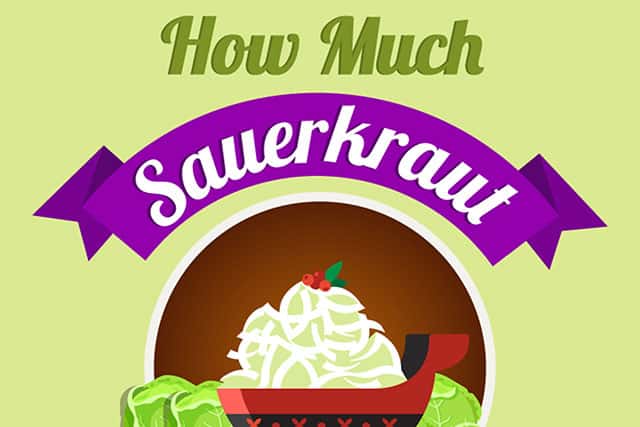

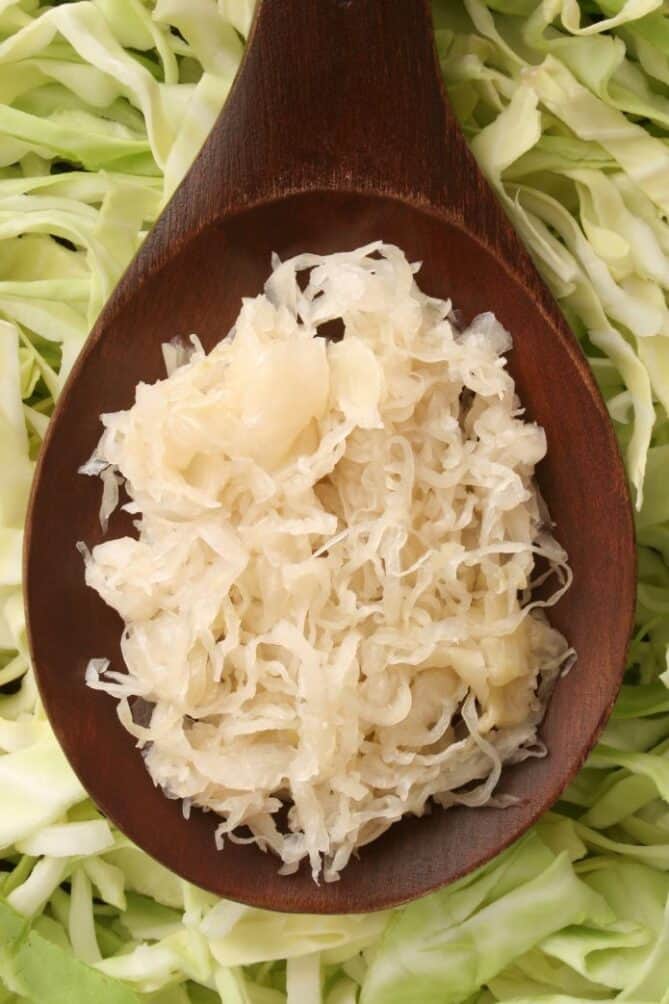

 This post may contain affiliate links which won’t change your price but will share some commission.
This post may contain affiliate links which won’t change your price but will share some commission.